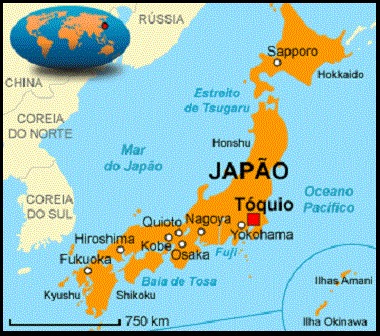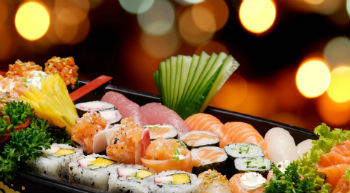The Japan is a country located in Asia and also called the “Land of the Rising Sun”.
Island country, has an area of 377 thousand square kilometers and is the third world economy.
General data
- Capital: Tokyo
- Population: 126 730 000
- Government regime: parliamentary monarchy
- Monarch: Emperor Akhito
- Prime Minister: Shinzō Abe
- Currency: yen
- Religion: Shinto, Buddhism
- Language: Japanese
Flag of Japan
The flag of Japan displays a circle that represents the sun. Also called Hinomaru , the flag has been used since 1870.
The drawing has been used since the 12th century by ” samurai bushi” . In battle between the Taira and Minamoto clans, the samurai drew the circle of the Sun on fans, the so-called “gunsen” .
The figure began to appear in battles like that of Sekigahara, in 1600 and adorned in several panels.

Geography
The Japanese territory is made up of 3 thousand islands which, in aggregate, correspond to the areas of the Brazilian states of Santa Catarina and Rio Grande do Sul. The main islands are Honshu, Shikoku, Hokkaido, Kyushu.

The island is located between the Pacific Ocean and the Sea of Japan. It is part of the Pacific Fire Circle , with great tectonic instability, intense volcanic activity, in addition to poor soil, with a low supply of minerals and fuels.
The relief is formed by mountains and plateaus, and most of the territory is mountainous. In the region called Chubu in Central Honshu, there is a mountain range over 3,000 meters high.
The highest is Mount Fugi, which is 3,700 meters high and is located between Yamanashi and Shizuoka provinces.
Because of the relief, Japan is marked by intense volcanic activity. There are now 80 active volcanoes in the country and most are capable of causing intense destruction.
Seismic activity is also intense due to the energy of the earth’s crust. The last large-scale earthquake was recorded in 2001, reaching 9 degrees on the Richter scale. According to Japanese authorities, the number of dead and missing has reached 19,000 people.
Hydrography
The longest and most important river in Japan is the Shinano, 367 kilometers long. Also of great importance are the rivers Chubu, Tone and Ishikari.
The topography directly influences the course, driving strong currents towards the sea. This feature resulted in geological formation, such as plains and deltas.
Climate
Japan is under the influence of the subarctic climate where the four seasons are well defined.
Winter is influenced by seasonal winds and part of the territory, especially the mountainous region, is influenced by heavy snowfalls. At that time, the average temperature is 5ºC.
Japanese autumn is marked by typhoons. At least 30 typhoons hit the archipelago at this time of year.
In the summer, the rains are intense and the average temperatures reach 30ºC. The relative humidity of the air is high during this period and there are constant rains and storms. The temperature fluctuates a lot in the Japanese spring, also marked by hot winds and low pressure.
Economy
Japan is among the largest economies in the world and, until the 1990s, it was the second, behind only the United States. Today, in third place, it has been overtaken by China .
The technological industry is its main source of income and the highlights are for production in the sectors of information technology, electronics, robotics and nanotechnology.

At least 85% of Japan’s industrial production is located in the regions of Tokyo and Osaka, which together form the largest megalopolis in the country.
Due to the limited territory, there is a small part of arable land. Rice production is the most important, but there is also an investment in growing fruits and vegetables.
History
The settlement of the territory now occupied by Japan began in the 3rd century BC From the 6th century on, the region was unified and, only in the 16th century, it came into contact with the European.
Through Portuguese and Spanish navigators, Japan began the process of trade with the Western world. Between 1542 and 1543, Portuguese navigators docked at Tanegashima beach.
Japanese and Portuguese started the process of trade. However, the imposition of Christianity caused local governments to prohibit the entry of foreigners and the exit of Japanese people.
In the 16th century, Japan still limited foreign trade to the Portuguese and Dutch. This isolation, called “ sakoku” , was intended to preserve Japanese traditions and customs. Thus, foreigners were prohibited from entering the island and Japanese were not allowed to leave.
This regime, under the command of the Tokugawa clan, was militarized. It started in 1603 and lasted until the arrival of the Americans in 1853. A year later, Japan signed the Kanagawa Treaty, which resulted in the end of Tokugawa rule.
Through the Meiji Revolution , the industrialization process began in 1868, when Emperor Mitsuhito came to power.
This period was called Era Meiji (1868-1912) and was marked by investments in means of transport, mainly railways, as well as ports and mines. Education focused on the qualification of labor has been universalized.
The economy was dominated by family clans that infiltrated commerce, finance and industry of all sizes.
During this period, the industrialization process was hampered by the lack of raw materials, energy and a limited internal market.
In an attempt to overcome these obstacles, the government decided to invest in militarism to conquer new territories and form colonies.
Among the successive military campaigns, the first was the Sino-Japanese War, which took place between 1894 and 1895. At that time, Korea and Taiwan were occupied. When it defeated Russia between 1904 and 1905, Japan conquered the Sakhalin Islands.
Manchuria was occupied in 1931, where Pu Yi, the last Chinese emperor, was sent. Confident in its victories, Japan invaded China in 1937, a conflict that was part of World War II.
In 1941, the Japanese army invaded Pearl Harbor , Hawaii, and caused the United States to enter World War II.
The Americans fought the Japanese on several Pacific islands like Iwo Jiwa. In order to shorten the battles, atomic bombs were dropped on the cities of Hiroshima, on August 6, 1945, and Nagasaki, three days later.
Japan surrendered in September 1945 and was forced to accept the impositions of the United States, becoming its main ally.
The greatest social, economic and political transformation in Japanese society occurred at the end of World War II .
The United States determined Japan’s post-war change. In order to end the feudal regime and militarism, the Americans applied several measures:
- land reform;
- demilitarization of the island;
- their armed forces would be limited and used as self-defense;
- Japan became secular;
- the Emperor was no longer considered a god;
- the parliamentary monarchy became the government regime.
There was an impact on Japanese society, economy and culture under the justification of modernizing it and burying its feudal and military past.
The USA remained under control of Japanese territory until 1952, when Japan regained sovereignty.
The Japanese industrial model is among the explanations for the country’s rapid recovery. The adoption of Toyotism ensured that the country quickly reached the rank of the second richest nation in the world in the 1970s.
Mores
Despite being a country extremely linked to technology, traditional Japanese culture still has its place.
Several modern cultural products arrived in the West like the Manga. Characters such as “Hello Kitty”, ikebana (floral arrangements) and origami (paper folding) stand out.
On the other hand, martial arts like karate and judo are popularized all over the world.
Japanese cuisine conquered the world in the 1990s when Japanese restaurants were opened in major cities.

In the set of elements that make up Japanese Culture , the tea ceremony is among the most important. Called “chanoyo”, it marks meetings and gatherings. It was incorporated into Japanese culture in the 8th century, starting in China.
